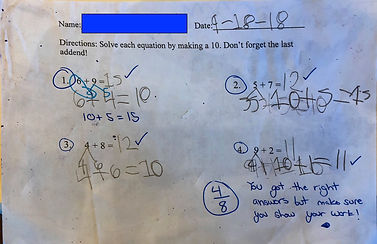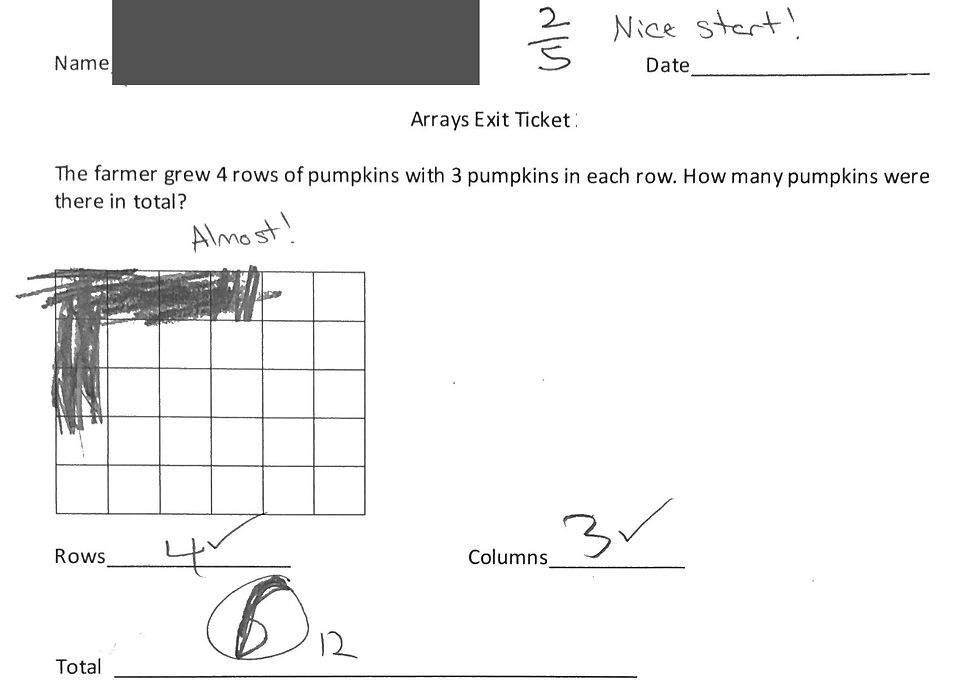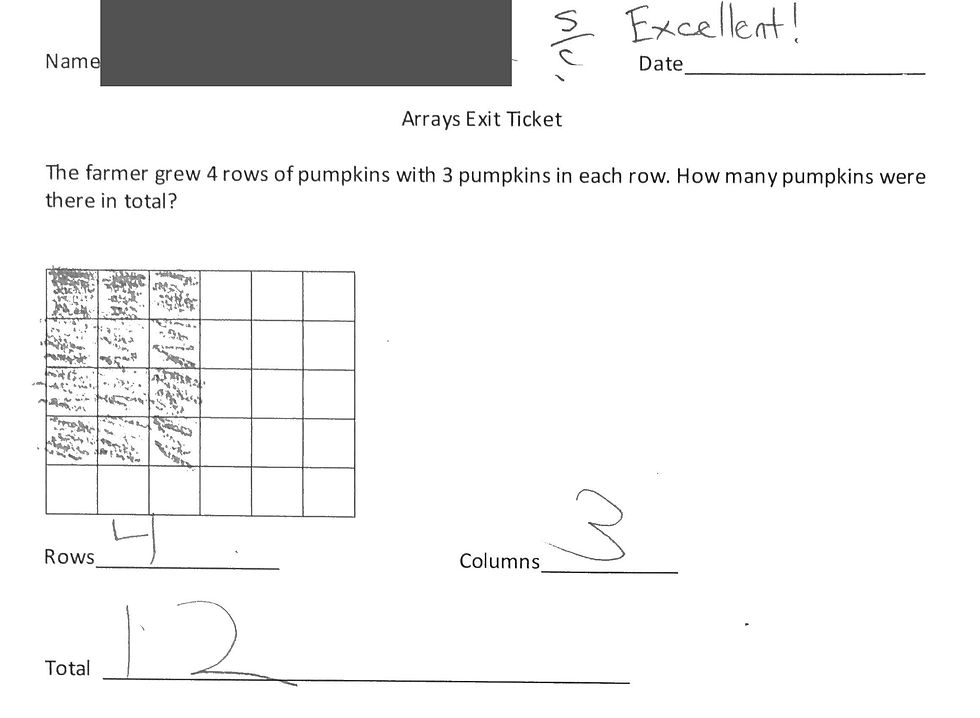Johanna Busch
Math Assessment
Math assessment allows me to target math instruction by understanding exactly which skills specific students have mastered and which they have not. Math skills build quickly on each other in second grade. Students move from adding and subtracting one digit numbers, to understanding place value and comparing numbers, to finally adding and subtracting two digit numbers. Students must master foundational skill before moving on to more advanced ones. For example, students cannot master adding two digit numbers if they cannot first add one digit numbers. Assessment allows me to adjust my math instruction to meet my students' needs regardless of their current skill level.
Diagnostic Assessment
End of Week Diagnostic
Students often complete a quick diagnostic assessment on Friday at the end of math. This assessment is based on the skill that we will be working on the following week. Students know that they are not expected to have already mastered this skill. Over the weekend, I analyze the data from these diagnostics to guide how I will teach the following week. If many students show mastery on a Friday diagnostic, I know to plan many extension activities for the following week to make sure all students are being challenged. Furthermore, these diagnostics show me what kinds of mistakes my students tend to make, so I can explicitly correct these misconceptions.
This document is an example of a Friday math assessment that took place the week before we began working on solving problems with three or more addends. This assessment showed me that many of my students were able to find the right answer to these problems by drawing and counting tallies. However, most did not show evidence of using known number combinations to solve the problem. Because of this, I planned to spend more time explicitly teaching students how to show their work without using tallies.
After analyzing results from the above diagnostic, I realized that students were generally using tallies to solve number string addition problems. Many students were making silly mistakes because they were trying to organize and count large numbers of tallies. Based on this assessment data, I decided to plan to explicitly teach students how to solve these types of problems using more effective strategies such as finding ten or doubles.
Here is one of the math lesson plans I taught the week after the diagnostic.
Formative Assessment
White Boards
I use white boards almost every day to assess student mastery during the guided practice portion of our lesson. After I model a new skill for students, we complete a few problems together. As students are working, I watch for evidence of misconceptions. If I notice that many students have the same misconception or are making similar mistakes, I will call students back together to quickly reteach or clear up any confusion. Furthermore, if I notice that most students already have mastered a skill, I will scaffold less during the guided practice portion. Using whiteboards allows me to use assessment results to make real time adjustments to my lesson to better meet my students' needs.

This image depicts a student who was learning how to add two one digit numbers by making a ten. He had to figure out what he needed to add to six to make a ten. Then, he split the second addend based on this information. Finally, the student rewrote the equation as ten plus three and found the answer.
During this lesson, I called students back to attention multiple times to emphasize the importance of staying organized after I noticed many of them were struggling to rewrite the equation because they couldn't read their own work.
Exit Tickets
Exit tickets are the primary way that I assess mastery of a skill at the end of a daily lesson. At the beginning of each class, I show students one of the problems from the exit ticket. This way, students know what they are expected to learn by the end of the lesson. I do my best to grade exit tickets during lunch and pass them back before students leave for the day. The combination of clear expectations and quick feedback engages students. Exit tickets are the primary way they know if they are meeting expectations in math class.
Below are two examples of exit tickets students completed after practicing using whiteboards (see above). The student on the left has achieved mastery of the skill we were working on that day (adding two one digit numbers by making a ten). Though the student on the right got the correct answer to all four problems, he did not show coherent work. This tells me that I need to reinforce this skill with the student on the right the next day during math small groups. If most students do not demonstrate mastery on an exit ticket, that is evidence that I need to reteach the same skill the following day and give students more time to practice it before moving on.


After grading exit tickets, I identify student misconceptions. I use the exit ticket data to decide if I need to reteach the material or not. If many students have not achieved mastery of an objective, I will plan a reteach lesson. When planning the reteach, I identify what specific misconceptions students had. I then think about how I could address these misconceptions as a part of a lesson. This data helps me decide how to reteach a lesson. Here is an example of a skill that I decided to reteach based on exit ticket data.
Below is the original array lesson plan that I taught. Students used Cheerios to represent arrays based on word problems. Students drew these arrays and used them to answer word problems. Students were assessed on their mastery of this objective with an exit ticket.
Here are some of the exit tickets from the above lesson. Students struggled to represent the story problem as an array. While my highest students succeeded on this exit ticket, most students did not. I analyzed these exit tickets to find common mistakes that students were making. The exit tickets below show some of these misconceptions. Many students were confused by columns and rows or only colored in the outer columns and rows in their array. Students also often added the number of rows and columns togethers (4 + 3 = 7) rather than using repeated addition ( 4+ 4 +4 = 12) to find the answer. Based on this formative assessment data, I decided to plan a lesson plan reteaching this objective with a focus on correcting these two misconceptions identified in the exit tickets.

This is the exit ticket of a student with an IEP. This student flipped rows and columns in his representation and was did not fill in his array. He also was unable to find the total number of pumpkins.

This is the exit ticket of a student with an average math level compared to the rest of the class. This student was unable to correctly represent the story problem as an array. He also added the number of rows and columns rather than using repeated addition.

This is the exit ticket of a student who excels at math. This student was able to correctly represent this problem as an array and solve.

This is the exit ticket of a student with an IEP. This student flipped rows and columns in his representation and was did not fill in his array. He also was unable to find the total number of pumpkins.
After analyzing the exit tickets, I decided that students had not achieved mastery of this skill. Only sixteen of my thirty students scored 80% or above on this exit ticket. Many students still struggled to represent problems in rows and columns. Even more students struggled to use their array to find the total number. Based on this assessment information, I decided to reteach this lesson. The reteach lesson plan is shown below.
Below is the plan for my reteach of arrays. I used the two common mistakes identified in the exit tickets shown above to guide this lesson plan. I did not use Cheerios and instead more explicitly taught the steps required to draw an array. I also decided to explicitly teach students how to represent the arrays and story problems as repeated addition sentences. I decided to do this to help students avoid the common mistake of adding the number of rows and columns together. The data from the exit tickets guided these instructional decisions.
At the end of this reteach lesson, I assessed student mastery of this objective with a similar exit ticket. This exit ticket had space for students to write the repeated addition sentence to remind them to show their work and not just add the number of rows and columns together. A few examples of student work on this exit ticket are shown below.

This is a student with an IEP who generally struggles in math class. This student only scored 2/5 on the first array exit ticket. After the reteach, the student achieved mastery.

This exit ticket was completed by a high student after the array lesson was retaught. Though this student had did well on the previous exit ticket, the retaught lesson gave them an opportunity to write repeated addition sentences, which they did correctly in this exit ticket.

This is a student with an IEP who generally struggles in math class. This student only scored 2/5 on the first array exit ticket. After the reteach, the student achieved mastery.
I know that the reteach of this skill was effective because I monitor student progress on exit tickets. I monitor student exit ticket scores on printed grade book spreadsheets which I keep in a binder. I record each student's score and the total number of students who achieved mastery (80%) on each exit ticket. This is an easy and sustainable way for me to monitor student progress on exit tickets. It is crucial that I am able to quickly record student progress so that I can analyze results while they are still relevant to the material being taught.
Here is the spreadsheet where I recorded array exit ticket scores for the original and retaught lessons. Using a handwritten spreadsheet allows me to monitor student progress by quickly recording scores and counting how many students achieved mastery.
Twenty-seven out of my thirty students scored above 80% on this exit ticket. Many students who had failed the previous exit ticket just a few days earlier received perfect scores. This success was possible because my progress monitoring system revealed that many students were not meeting expectations. I then used common misconceptions found in a formative assessment to inform my instructional practices.
Sprints
Students complete a sprint as their math warm up every Monday, Wednesday, and Friday. Sprints are differentiated based on students' success the week before. Once a student is able to successfully complete a whole sprint in two minutes, the student moves on to a harder sprint. Sprints are one way that I build student investment in assessment. Students are very motivated to get faster at completing sprints and to move up a "level" to a more challenging sprint. This encourages students to build math fluency.
This is an example the same sprint which a student completed on Monday and Friday. Though the student correctly found all the sums, he was not able to solve any of the missing addend problems on either attempt. This is evidence that I need to quickly teach him a strategy to solve these types of problems during small group so that he can move up to the next sprint the following week.
Summative Assessment
Quizzes
Students complete quizzes every week or two. Quizzes are short assessments that assess student mastery of a few different skills. I use quizzes to figure out if students know what strategy they need to use to solve a problem. While the skill students need to use to complete an exit ticket is usually very clear, quizzes often require students to choose from a few different strategies we have learned. Quizzes also usually include a writing component to see if students can articulate a conceptual understanding of skills that they are working on. I use quiz results to figure out what needs to be accomplished for students to succeed on the unit test. I then adjust the plan for the coming weeks based on these results.
This is an example of a quiz students completed after a week of practicing finding the sum of three addends. The writing prompt at the end helped to demonstrate student understanding of the concepts behind the way we learned how to solve these problems.
Unit Assessments
Students complete a unit test at the end of every unit. Units usually last between four and eight weeks. Unit tests assess student mastery of a broader range of skills which have built on each other all year. I use unit tests to track student growth over a longer period of time. These tests also track which students have achieved mastery of a group of skills and which have not. These assessments show me which concepts students have already mastered and which concepts I need to make sure I cycle back to and reteach in the future.
This is the Unit 1 assessment of a student with advanced math abilities. This student demonstrated mastery of all the skills that were tested on the Unit 1 assessment including coin identification, number strings, and a few different types of story problems.
This is the Unit 1 Assessment of a student with on target math abilities. This student is very close to achieving mastery of all skills taught on this unit test. She conceptually understood how to solve one step addition and subtraction problems. However, she made a few computation errors. This indicates that she needs additional practice with addition and subtraction strategies.
This is the Unit 1 Assessment of a student with an IEP. This student struggled with the concepts learned in this unit. While he was able to differentiate subtraction and addition problems, he solved all of the problems using tallies instead of more advanced strategies we had practiced. This prevented him from accurately solving most of the problems on the assessment.
I monitor student progress on unit assessments on a spreadsheet. I record each student's score and the number of students who have achieved mastery, meaning they scored above 80%. So far this year, students have only taken the Unit 1 assessment. In the coming months, I will add their unit assessment scores for future unit assessments, allowing me to track student progress towards end of year goals.
This is the spreadsheet that I used to monitor student progress on unit assessments. This spreadsheet shows that twenty-one of my thirty students achieved mastery on this unit assessment.
In addition to just monitoring student's scores, I also monitor which skills students are succeeding and and struggling with. The results of each unit test is analyzed during my weekly collaborative planning meeting with the other second grade teachers and our instructional coach. During this meeting, we share our data (using the above spreadsheet). We also go through the assessment question by question. During this time, I look more deeply through my students assessments to see where there were skill deficits. I record notes for each question, noting overall student strengths and ways to improve on areas of weakness.
Completing this analysis with my team members and instructional coach holds me accountable to monitoring student progress and using this data to guide instructional decisions. After analyzing the unit 1 assessment, we decided to create two new centers (coin identification and enough for the class) because some but not all students needed additional practice with these skills. We also decided to reteach and add more time to practice two digit subtraction and addition strategies during the next unit. Finally, we decided to plan to focus on reteaching complex word problems like problem 6 during Unit 3. I use this analysis of my summative assessment data to inform my practice for the following weeks and months.
Here are my collaborative planning notes from a meeting spent analyzing results on the unit 1 assessment. I note general trends we identified for each problem as well as several to do steps at the bottom.
I engage students in their own growth by posting the percent of students who achieved mastery on a cloud display in my room. Students are working to get "80 at 80." Our goal is for 80% of our class to receive 80% or above on unit assessments. As students complete more unit assessments, I will post the percentages on clouds so students can "float up to mastery." Seeing our progress and potential on the wall everyday motivates my students to continue working for growth.

This is the unit 1 assessment cloud that I have already posted on our class's unit assessment display. 70% of my class achieved mastery on our first unit assessment.